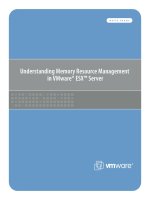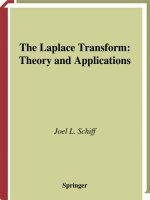resource management in wireless networking (network theory and applications)
Bạn đang xem bản rút gọn của tài liệu. Xem và tải ngay bản đầy đủ của tài liệu tại đây (17.78 MB, 716 trang )
RESOURCE MANAGEMENT IN
WIRELESS NETWORKING
Network Theory and Applications
Volume 16
Managing Editors:
Ding-Zhu Du
University of Minnesota, U.S.A.
Cauligi Raghavendra
University of Southern Califorina, U.S.A.
RESOURCE MANAGEMENT IN
WIRELESS NETWORKING
Edited by
MIHAELA CARDEI
Florida Atlantic University, Boca-Raton, FL
IONUT CARDEI
Florida Atlantic University, Boca-Raton, FL
DING-ZHU DU
University of Minnesota, Minneapolis, MN
Springer
eBook ISBN: 0-387-23808-5
Print ISBN: 0-387-23807-7
Print ©2005 Springer Science + Business Media, Inc.
All rights reserved
No part of this eBook may be reproduced or transmitted in any form or by any means, electronic,
mechanical, recording, or otherwise, without written consent from the Publisher
Created in the United States of America
Boston
©2005 Springer Science + Business Media, Inc.
Visit Springer's eBookstore at:
and the Springer Global Website Online at:
Preface
Following the pattern of the Internet growth in popularity, started in the early
1990s, the current unprecedented expansion of wireless technology promises to have
an even greater effect on how people communicate and interact, with considerable
socio-economic impact all over the world. The driving force behind this growth is
the remarkable progress in component miniaturization, integration, and also develop-
ments in waveforms, coding, and communication protocols.
Besides established infrastructure-based wireless networks (cellular, WLAN, satel-
lite) ad-hoc wireless networks emerge as a new platform for distributed applications
and for personal communication in scenarios where deploying infrastructure is not
feasible. In ad-hoc wireless networks, each node is capable of forwarding packets on
behalf of other nodes, so that multi-hop paths provide end-to-end connectivity. The
increased flexibility and mobility of ad-hoc wireless networks are favored for applica-
tions in law enforcement, homeland defense and military.
In a world where wireless networks become increasingly interoperable with each
other and with the high-speed wired Internet, personal communication systems will
transform into universal terminals with instant access to variate content and able of
handle demanding tasks, such as multimedia and real-time video. With users roaming
between networks, and with wide variation in wireless link quality even in a single
domain, the communications terminal must continue to provide a level of Quality
of Service that is acceptable to the user and conforms to a contracted Service Level
Agreement.
Taking these into considerations, the network must provide mechanisms for con-
trolling connection admission, service differentiation, end-to-end communication delay
and connection data rate. These functions are different aspects of network resource
management that contribute to provisioning of Quality of Service.
For some applications, a critical element is application lifetime - the time the ap-
plication remains operational before energy reserves at network nodes are depleted
and normal operation is hindered. To extend the application lifetime, it is essential to
have judicious power management at each node and to employ energy-efficient com-
munication protocols that address the energy efficiency issue at the network scale.
Extensive research has been performed over the last few years in the area of effec-
tive network resource management, QoS and energy-efficient protocols for wireless
networks. This book presents a snapshot of representative work in the field and
targets an audience that includes researchers, faculty members, students and other
professionals interested in this field.
The chapters in this book cover key topics from the area of resource management
and QoS in wireless networks, starting from channel scheduling, QoS-aware medium
access control, to QoS routing, resource discovery, energy-efficient multicast and ar-
chitectures for end-to-end QoS. The book content is structured as follows:
vi
Preface
Section 1 chapters survey resource management architectures for multimedia trans-
mission, for IP-based ad-hoc wireless networks and for UMTS cellular networks.
Section 2 presents research on channel allocation, packet scheduling, bandwidth man-
agement and a framework for end-to-end statistical delay guarantees in ad-hoc wireless
networks.
Section 3 addresses issues in resource management and QoS for Medium Access Con-
trol protocols. The IEEE 802.11e QoS extensions and resource management for Blue-
tooth networks are analyzed in detail. Novel approaches for Spatial TDMA are in-
troduced and energy-efficient wireless MAC protocols are surveyed.
Section 4 provides a comprehensive overview of routing and QoS in mobile and ad-
hoc wireless networks. Chapters in this section also present research in resource
localization and discovery for ad-hoc wireless networks.
Section 5 surveys the state of the art in energy-efficient broadcast and multicast proto-
cols for ad-hoc wireless networks, increasingly important in the context of multimedia
and content delivery in emerging 4G wireless networks.
Section 6 chapters describe techniques for improving the quality of wireless connec-
tions, at the link layer and at the transport layer, by improving the performance of
TCP over wireless networks.
This book is the collective contribution of top world researchers in the field of
wireless communications and networking. We would like to take the opportunity to
thank the authors, the anonymous referees and the publisher who guided us through
the process and made this book possible.
Mihaela Cardei, Ionut Cardei and Ding-Zhu Du
Florida Atlantic University and University of Minnesota
Contents
Preface
v
SECTION I Resource Management Architectures
QoS for Multimedia Services in Wireless Networks
Hua Zhu and Imrich Chlamtac
1.
2.
Evolution of QoS
Introduction
2.1.
2.2.
2.3.
2.4.
2.5.
From Local Operating Systems to Networks
From Wireline to Wireless and Mobile
From Centralized to Distributed or Hybrid
From Homogeneous to Heterogeneous
From Separate Layer Support to End-to-End Guarantees
3.
Components of QoS
3.1.
3.2.
3.3.
3.4.
3.5.
QoS Specifications
QoS Mapping
QoS Policies
QoS Mechanisms
QoS Monitoring and Adaptation
4.
5.
Architectures
Summary
References
Cross-Layer Architectures for Bandwidth Management in
Wireless Networks
Klara Nahrstedt, Samarth H. Shah, and Kai Chen
1.
Introduction
1.1
.
1.2.
1.3.
1.4.
Overview
Focus
Cross-Layer Design
Outline
2.
3.
Essential Tasks in Bandwidth Management
Description of Cross-Layer Architectures
3.1.
3.2.
3.3.
3.4.
TIMELY
Utility-Fair
INSIGNIA
dRSVP
1
2
3
3
3
4
5
5
5
5
7
9
10
27
28
33
34
41
42
42
42
43
43
44
47
47
48
50
51
viii
Contents
3.5.
3.6.
SWAN
4.
5.
Comparision
Future Directions
5.1.
5.2.
5.3.
5.4.
Improving Accuracy of MAC-layer Available Bandwidth Estimation
QoS using IEEE 802.11e
Network-Layer Improvements
Co-ordinated Bandwidth Allocation
Bandwidth Management (BM)
6.
Conclusion
References
51
53
54
55
55
57
58
59
60
60
Resource Management and Connection Admission
Control in Wireless Networks
Tuna Tugcu
1
.
2.
Introduction
Resource Management and Connection Admission Control
2.1.
2.2.
2.3.
2.4.
Managing the Radio Spectrum
Tradeoff Between Connection Blocking and Connection Dropping Rates
Resource Management in UMTS
Quality of Service
3.
4.
Connection Admission Control in the Next Generation
Conclusion
References
63
63
65
65
66
69
71
74
76
78
SECTION II Channel Allocation and Scheduling
Real-Time Guarantees in Wireless Networks
Shengquan Wang, Ripal Nathuji, Riccardo Bettati, and Wei Zhao
1.
2.
Introduction
Models of Wireless Networks and Links
2.1.
2.2.
2.3.
2.4.
Overview
Framework of a Wireless Link
Markov Link Model
Stochastic Service Curve of a Wireless Link
3.
4.
5.
6.
Trafficc Model
Statistical Delay Analysis in a Wireless Network
Admission Control Mechanisms
5.1.
5.2.
Delay-Based Admission Control (DBAC)
Utilization-Based Admission Control (UBAC)
Performance Evaluation
82
84
84
85
86
87
89
90
94
95
95
96
81
Contents
ix
6.1.
6.2.
WCAU Comparison
Admission Probability Comparison
7.
Conclusions
References
Fair Real-Time Scheduling over a Wireless LAN
Insik Shin, Sanjeev Khanna, and Insup Lee
1.
2.
3.
Introduction
Related Work
Scheduling Model and Goals
3.1.
3.2.
System Model
Scheduling Objectives
4.
5.
Theoretical Results
Online Scheduling Algorithms
5.1.
5.2.
Online Scheduling Algorithms
Example of Online Scheduling Algorithms
6.
7.
Wireless Error Handling
Simulation Results
7.1.
7.2.
Simulation Environments
Simulation Results
8.
Conclusion
References
97
98
99
104
105
106
106
107
108
110
110
113
114
115
115
116
119
120
103
100
Inter-Domain Radio Resource Management for Wireless LANs
Yasuhiko Matsunaga and Randy H. Katz
1.
2.
Introduction
Regulations and Standardization Activities
2.1.
2.2.
Unlicensed Band
Licensed Band
3.
Inter-Domain Radio Resource Management
3.1.
3.2.
3.3.
Radio Resource Broker Concept
Resource Usage Optimization
Radio Resource Redistribution
4.
Workload Characterization
4.1.
4.2.
Measurement
Empirical WLAN Workload Model
5.
Performance Evaluation
5.1.
5.2.
Simulation Methodology
Dynamic Channel Optimization
122
123
124
124
127
127
127
128
130
131
131
132
134
134
134
x
Contents
5.3.
Radio Resource Redistribution
6.
7.
Related Work
Conclusion
References
137
137
139
139
High Performance Broadband Wireless Infrastructure
Extension Networks
Rene L. Cruz, Arvind Santhanam, and Bongyong Song
1.
Introduction
1.1.
1.2.
1.3.
1.4.
1.5.
A Broadband Wireless Network
Comparative Advantages of Wireless Networks
Technical Challenges facing Wireless Networks
Approaches to Increase Spectral Efficiency: Link Scheduling and
Power Control
Multihop Networking using Multiple Antennas
2.
3.
System Model
Optimal Policy
3.1.
3.2.
Problem Formulation : Primal Problem
Outline of our approach
4.
5.
Numerical Examples
Closing Remarks
References
Truthful Computing in Wireless Networks
Xiang- Yang Li and WeiZhao Wang
1.
Introduction
1.1.
1.2.
1.3.
Ad Hoc Wireless Networks
Why Truthful Computing
Approaches and Challenges
2.
3.
Credit Based Methods
Incentive Based Method
3.1.
3.2.
3.3.
3.4.
3.5.
3.6.
Mechanism Design
Truthful Mechanism Design
VCG Based Mechanism
Network Model
Unicast
Multicast
4.
Other Problems
4.1.
4.2.
Non-cooperation of Topology Control
Incentives for Cooperation in Peer-to-Peer Networks
166
166
167
167
168
171
171
172
173
174
174
183
189
190
191
165
142
143
143
145
146
146
148
149
155
156
156
157
162
162
Contents
xi
4.3.
4.4.
4.5.
Resource Allocation
Cooperation in MAC Layer
Cooperation for TCP/IP on End-node
5.
Conclusion
References
SECTION III
Medium Access Control
Resource Allocation of Spatial Time Division Multiple Access in
Multi-hop Radio Networks
Peter Värbrand and Di Yuan
1.
2.
Introduction
Networking Model
2.1.
2.2.
2.3.
Notation and Assumptions
Assignment Strategies
Network Throughput
3.
4.
5.
Problem Definitions
Prior Work
Mathematical Models
5.1.
5.2.
Node-slot and Link-slot Formulations
Formulations Based on Transmission Groups
6.
Solution Methods
6.1.
6.2.
A Column Generation Method
A Greedy Heuristic
7.
8.
Numerical Results
Conclusions and Perspectives
References
QoS Enhancement for the IEEE 802.11e Distributed
Wireless LANs
Yang Xiao and Haizhon Li
1.
2.
3.
Introduction
IEEE 802.11/.11b/.11a/.11g PHY
IEEE 802.11 MAC
3.1.
3.2.
The DCF
The PCF
4.
5.
IEEE 802.11e EDCF
IEEE 802.11e MAC Enhancements
5.1. Direct Link Protocol
192
192
193
193
194
198
199
201
201
203
203
204
206
208
208
210
211
211
213
214
217
219
223
224
225
227
227
230
230
233
233
xii
Contents
5.2.
Block Acknowledgment Protocol
6.
Related work for the EDCF
6.1.
6.2.
ServiceDifferentiation
MAC Enhancements
7.
Evaluation via Simulations
7.1.
7.2.
7.3.
7.4.
Simulation Setup
Throughput, Delay, Fairness Index Factor, and Failure Transmission
under Small Traffic Load
Throughput, Delay, Fairness Index Factor, and Failure Transmission
under Large Traffic Load
Effects of Buffer Size on Delay, Queuing Delay Ratio, Drop Ratio,
and Buffer Overflow Ratio
8.
Conclusions
References
Time-Domain, Frequency-Domain, and Network Level Resource
Management Schemes in Bluetooth Networks
Yu-Kwong Kwok
1.
Introduction
1.1.
1.2.
1.3.
Bluetooth Overview
Resource Management Motivations and Opportunities
Techniques Based on Different Domains
2.
Resource Management Schemes for Coexistence
2.1.
2.2.
2.3.
2.4.
2.5.
2.6.
2.7.
2.8.
2.9.
Overview
An Integrated Inter-Piconet Interference Avoidance Approach
An Inter-Piconet Interference Coping SAR Approach
MAC Layer Scheduling for Colocated Bluetooth and IEEE 802.11
Adaptive Frequency Hopping: A Bluetooth Solo Against
IEEE 802.11 Interference
Knowledge Based Bluetooth AFH
Overlap Avoidance Traffic Scheduling
BlueStar Coexistence Scheme
Other Approaches
Performance Studies
2.10.
2.11.
Discussion
3.
Resource Management Schemes for Connectivity: Piconet and
Scatternet Time-Slot Scheduling
3.1.
3.2.
3.3.
3.4.
Overview
Piconet Queue-State-Dependent Scheduling
Piconet SAR and Scheduling
Piconet Link-State History Based Scheduling
254
254
257
260
261
261
262
263
264
265
267
269
270
271
271
272
273
273
274
275
276
252
234
235
235
236
236
237
237
239
241
243
245
Contents
xiii
3.5.
3.6.
3.7.
3.8.
3.9.
Piconet Sniff Scheduling
Scatternet Nodes Randomized Rendezvous Scheduling
Locally Coordinated Scheduling in Scatternets
Maximum Distance Rendezvous Scheduling in Scatternets
An Integrated Time-Slot Scheduling Approach
Performance Studies
3.10.
3.11.
Discussion
4.
Resource Management Schemes for Connectivity: Scatternet
Formation and Routing
4.1.
4.2.
4.3.
4.4.
4.5.
4.6.
4.7.
4.8.
4.9.
Overview
BTCP: Bluetooth Topology Construction Protocol
Bluetree Scatternet Formation
Bluenet Scatternet Formation
BlueConstellation Scatternet Formation
Randomized Scatternet Formation
Scatternet Formation Based on Search Trees
BlueRing Scatternet Formation
4.10.
4.11.
4.12.
4.13.
RVM Routing
On-Demand Scatternet Routing
Zone Routing Protocol
Discussion
5.
6.
Further Research Opportunities
Summary
References
Energy-Efficient MAC Layer Protocols in Ad Hoc Networks
Fang Liu, Kai Xing, Xiuzhen Cheng, and Shmuel Rotenstreich
1.
2.
Introduction
Sources of Power Waste and Low-Power MAC Design Principles
2.1.
2.2.
Major Sources of Energy Waste
Low-Power MAC Design Guidelines
3.
Scheduling-based Mechanism
3.1.
3.2.
3.3.
3.4.
3.5.
Motivation
CDMA Ad Hoc Networks
TDMA
FDMA
Related Protocols
4.
Power Control Techniques
4.1.
Mechanism
Scatternet Formation Based on de Bruijn Graphs
277
278
278
279
279
281
282
282
282
283
284
284
285
285
286
287
288
289
289
291
291
291
293
293
300
301
303
303
305
307
308
309
311
312
312
314
315
xiv
Contents
4.2.
Related Protocols
5.
Power Off Mechanism
5.1.
5.2.
Mechanism
Related Protocols
6.
Multi Channel Mechanism
6.1.
6.2.
Mechanism
Related Protocols
7.
Antenna-based Mechanism
7.1.
7.2.
Mechanism
Related Protocols
8.
9.
Others
Conclusion
References
SECTION IV
Routing and Resource Discovery
QoS-Based Routing in Wireless Mobile Networks
Eylem Ekici
1.
2.
Introduction
Quality of Service Based Routing
2.1.
2.2.
2.3.
Network State
Route Calculation and Session Establishment
Session Termination
3.
QoS-Based Routing in Ad Hoc Networks
3.1.
3.2.
3.3.
Effect of Ad Hoc Network Properties on QoS-Based Routing
Maintenance of QoS Paths
Example QoS-Based Routing Protocols
4.
Conclusions
References
Quality of Service Routing in Mobile Ad Hoc Networks
Imad Jawhar and Jie Wu
1.
2.
Introduction
Overview
2.1.
2.2.
2.3.
2.4.
2.5.
DSR - the Dynamic Source Routing Protocol
AODV - The Ad Hoc On-demand Distance-Vector Protocol
TORA - The Temporally Ordered Routing Algorithm
DSDV - The Destination Sequenced Distance Vector Protocol
Other Approaches
3.
QoS Routing Protocols: Models and Classification
343
344
346
348
349
350
350
351
352
361
362
366
367
368
369
370
371
372
372
365
342
317
321
321
322
325
325
327
329
329
330
333
334
334
Contents
xv
3.1.
3.2.
QoS Models in MANETs
QoS Routing Protocols
4.
Sample QoS Routing Protocols
4.1
4.2
4.3
4.4
Extensions of DSR
Extensions of AODV
Extensions of TORA
Extensions of DSDV
5.
6.
Other QoS Routing Protocols and Related Issues
Conclusions and Future Research
References
Topology Management of Hierarchical Mobile Ad Hoc Networks
Mario Gerla and Kaixin Xu
1.
2.
3.
Introduction
Ad Hoc Network with Mobile Backbones
Mobile Backbone Node Election
3.1.
3.2.
Random Competition based Clustering
Stability of the Backbone Nodes
4.
5.
Routing in Mobile Backbone Network
5.1.
5.2.
Landmark Ad Hoc Routing (LANMAR) Overview
Hierarchical Landmark Ad Hoc Routing (H-LANMAR)
6.
Performance Evaluation
6.1.
6.2.
Performance Evaluation of Backbone Node Election
Performance Evaluation of Backbone Node Automatic Repositioning
7.
Conclusion
References
Efficient Resource Discovery in Wireless AdHoc Networks:
Contacts Do Help
Ahmed Helmy
1.
2.
3.
Introduction
Overview of Resource Discovery Approaches
Resource Discovery Approaches
3.1.
3.2.
3.3.
3.4.
Flooding-based Approaches
Ad Hoc On-demand Routing
Hierarchical Approaches
Hybrid, Loose Hierarchy
4.
Contact-based Resource Discovery Architectural Overview,
Design and Evaluation
373
375
376
376
385
388
391
393
395
397
401
402
404
406
406
408
409
411
411
412
413
413
415
417
417
419
420
422
423
423
425
431
435
439
Backbone Node Automatic Respositioning
xvi
Contents
4.1.
4.2.
Contact Selection and Search Policies
Request Forwarding and Processing
5.
Evaluation and Comparison
5.1.
5.2.
5.3.
Simulation Setup
Overhead per Query
Scalability Analysis of Total Overhead
6.
7.
Conclusions
Acknowledgements
References
Hybrid Routing Protocols for Mobile Ad-hoc Networks
Lan Wang and Stephan Olariu
1.
2.
3.
Introduction
MANET Routing Protocols: a Quick Review
Hybrid MANET Routing Protocols
3.1.
3.2.
3.3.
Cluster-Centric Protocols
Node-Centric Protocols
Comparison of Different Hybrid Routing Protocols
4.
TZRP - A Two-Zone Hybrid Routing Protocol
4.1.
4.2.
4.3.
4.4.
Motivation
Basic Idea of TZRP
Details of TZRP
Simulation Results and Discussion
5.
Concluding Remarks
References
Localization in Wireless Ad Hoc Networks
Dmitri D. Perkins, Ramesh Tumati, Hongyi Wu, and Ikhlas Ajbar
1.
Introduction
1.1
What Are Ad Hoc Networks?
1.2
1.3
1.4
Why Localization in Ad Hoc Networks?
Why Not GPS?
Designing Localization Algorithms for Ad Hoc Networks
2
How Node Localization Works
2.1
2.2
Range-based Methods
Connectivity-based Approach
3
4
Localization Techniques in Infrastructured Systems
Localization Algorithms for Ad Hoc Networks
4.1
Range-based Algorithms
440
448
449
450
452
455
465
465
466
472
473
474
476
477
479
485
486
486
488
489
491
501
502
507
508
508
510
511
512
514
515
518
519
521
521
Contents
xvii
4.2
Connectivity-based Algorithms
5
Comparing Ad Hoc Localization Algorithms
References
SECTION V
Broadcast and Multicast
Energy-Efficient Broadcasting in Wireless Mobile
Ad Hoc Networks
François Ingelrest, David Simplot-Ryl, and
1.
Introduction
1.1.
1.2.
1.3.
Description of Wireless Ad Hoc Networks
The Broadcasting Task
Organization of this Chapter
2.
Preliminaries
2.1.
2.2.
2.3.
3.
Energy Efficient Broadcasting Without Range Adjustment
3.1.
3.2.
3.3.
3.4.
3.5.
3.6.
3.7.
3.8.
3.9.
3.10.
4.
Energy Efficient Broadcasting with Range Adjustment
4.1.
4.2.
4.3.
Centralized Protocols
Localized Protocols that Minimize Needed Radii
Localized Protocol that Uses a Target Radius
5.
Energy Efficient Broadcasting with Directional Antennas
5.1.
5.2.
5.3.
Centralized Protocols
Localized Protocols
Adaptive Directed LMST Broadcast Oriented Protocol (A-DLBOP)
6.
Conclusion
References
Communication Model
Assumptions
Energy Model
Clustering Based Broadcasting Protocols
Neighbor Elimination Based Broadcasting Protocols
Distance-based and Probabilistic Protocols
Coverage and Connected Dominating Set Based Broadcasting
Forwarding Neighbors Based Broadcasting Protocols
Impact of Realistic Physical Layer
Beaconless Broadcasting
Double-Dominating Sets
Broadcasting in Hybrid Networks
Effects of MAC Layer and Mobility
531
536
540
543
544
544
546
548
548
548
549
551
552
553
553
553
554
555
558
559
559
560
561
561
562
562
566
570
571
571
574
576
577
xviii
Contents
Energy-Efficient Multicast Protocols
Sandeep K. S. Gupta and Bin Wang
1.
2.
Introduction
Energy-Efficient Communication Techniques
2.1.
2.2.
2.3.
2.4.
Energy Consumption Model for Wireless Communication
Basic Techniques for Conserving Energy
Wireless Multicast Advantage
Why Link-Based View is Not Suitable for WANETs?
3.
Energy Metrics and Cost Models
3.1.
3.2.
Node Cost
Multicast Tree Cost
4.
Constructing Energy-Efficient Multicast Trees
4.1.
4.2.
4.3.
Protocols
Qualitative Analysis
Quantitative Results
5.
6.
A Framework for Energy-Efficient Multicast
Conclusions
References
IP3S: a Framework for Power-Conserving Multicast and Broadcast
Algorithms in Static Wireless Ad Hoc Networks
Hung Q. Ngo, Dazhen Pan, Shiva-Shankar Ramanna, and Suchita Kaundin
1.
2.
Introduction
Preliminaries
2.1.
2.2.
Communication Model
The Minimum Energy Consumption Broadcast Subgraph
(MECBS) Problem
2.3.
The Minimum Energy Consumption Multicast Subgraph
(MECMS) Problem
3.
Overview of ExistingWorks
3.1.
3.2.
3.3.
The Broadcast Case
The Multicast Case
The IP3S Framework
4.
5.
The IP3S Idea
Broadcasting
5.1.
5.2.
Centralized Algorithm
Distributed Algorithm
6.
Multicasting
6.1. Centralized Algorithm
583
584
585
585
586
586
588
589
590
592
594
594
598
602
605
606
607
61
0
611
612
612
613
614
614
614
615
616
617
619
619
622
624
624
Contents
xix
6.2.
Distributed Algorithm
7.
Simulation Results
7.1.
7.2.
Broadcasting
Multicasting
8.
Conclusions and FutureWorks
References
SECTION VI Radio Link and Transport
Radio Link Protocols for 3G CDMA Systems
Sajal K. Das and Mainak Chatterjee
1.
2.
Introduction
Radio Link Protocols
2.1.
2.2.
2.3.
Sequence Numbers
Hybrid ARQ
RLP Optimizations for Resource Management
3.
3G CDMA Systems
3.1.
3.2.
3G Reference Model
Layer 2 of IS-2000
4.
RLP in 3G Systems
4.1.
4.2.
4.3.
4.4.
4.5.
Evolution of Retransmission Schemes
Need for Faster Retransmissions
MAC Retransmissions for cdma2000
Fast ARQ
MAC Retransmissions for WCDMA
5.
Summary
References
A Survey on Improving TCP Performance over Wireless Networks
Xiang Chen, Hongqiang Zhai, Jianfeng Wang, and Yuguang Fang
1.
2.
Introduction
Overview of TCP
2.1.
2.2.
Basic Functionality of TCP
State-of-the-Art in Standard TCP
3.
TCP in One-Hop Wireless Networks
3.1.
3.2.
Challenges
Current Solutions
4.
TCP in Mobile Ad Hoc Networks
4.1.
Challenges
626
627
627
629
633
634
640
641
642
643
645
645
646
647
648
649
649
650
651
652
653
654
654
657
658
660
661
663
665
665
666
675
676
xx
Contents
4.2.
Current Solutions
5.
Future Research Directions
5.1.
5.2.
5.3.
TCP Fairness
Interactions among Different Layers
Compatibility with the Wired Internet
6.
Conclusions
References
679
688
688
688
689
689
690
QoS for Multimedia Services in Wireless Networks
Hua Zhu
Department of Electrical Engineering
University of Texas, Dallas, TX 75083
E-mail: zhuhua@utdallas . edu
Imrich Chlamtac
School of Engineering
University of Texas, Dallas, TX 75083
E-mail:
Content
s
1
Introduction
2
Evolution of QoS
2.1
2.2
2.3
2.4
2.5
From Local Operating Systems to Networks
From Wireline to Wireless and Mobile
From Centralized to Distributed or Hybrid
From Homogeneous to Heterogeneous
From Separate Layer Support to End-to-End Guarantees
3
3
3
4
5
5
2
3
Components of QoS
3.1
3.2
3.3
3.4
QoS Specifications
QoS
Mapping
QoS
Policies
QoS
Mechanisms
3.4.1
3.4.2
3.4.3
3.4.4
Multimedia Content
Operating
System
Communication Subsystem
Network
3.5
QoS Monitoring and Adaptation
5
5
7
9
10
10
15
16
23
27
4
5
6
Architectures
Summary
Acknowledgements
28
33
34
References
1
Introduction
In general, Quality of Service (QoS) is not related to any dedicated network
layer, rather it requires coordinated efforts from all layers. As such, QoS is
a broad concept that covers virtually every layer and every component in
the network and supporting services. The basic definition of QoS was given
for the first time in [10] as ‘the collective effect of service performance which
determine the degree of satisfaction of a user of the service.’ In [1], Vogel
et al. defined Quality of Service as follows: ‘ Quality of Service represents
the set of those quantitative and qualitative characteristics of a distributed
multimedia system necessary to achieve the required functionality of an ap-
plication’, while in [2], the definition of QoS was ‘a set of qualities related to
the collective behaviour of one or more object’. QoS is understood by IETF
as ‘ a set of service requirements to be met by the network while transporting
a flow.’ And in [3] Malamos et al. defined QoS as ‘the basic measure of how
well the system operates in order to meet the user’s requirements.’ In [9] QoS
is defined as ‘on umbrella term for a number of techniques that intelligently
match the needs of specific applications to the network resources available’.
The dramatic advances in wireless communications and multimedia tech-
niques have led to the development of next generation multimedia services
over wireless networks giving QoS an added importance. Two main fea-
tures characterize the next generation multimedia services: a wide range of
customized multimedia applications and the coexistence of different access
technologies, such as IEEE 802.11, Bluetooth, CDMA, satellite and infrared.
As a result, research on QoS has been shifted to the wireless, mobile or het-
erogeneous environment, brining with it additional challenges.
This chapter shows the impetus behind the impressive market demands
of multimedia services and applications with Quality of Service (QoS) guar-
antees over next generation wireless networks, and presents a representa-
2
tive collection of challenges and technological solutions of Quality of Service
(QoS) in its different aspects. In the following section, we review the evo-
lution and latest research activities of QoS. In Section 3, in order to have
an overall picture of QoS, we define and discuss the various components
involved in QoS provisioning. A summary of existing QoS architectures is
presented in Section 4. The paper concludes with an outlook on challenges
and opportunities for research on QoS in both near and long term future.
2
Evolution of QoS
In recent years, QoS has become ubiquitous, and omnipotent. The provi-
sioning of QoS experiences the evolvement from QoS-aware to QoS enable,
from local operating systems to networks, from wireline to wireless and mo-
bile, from centralized to distributed or hybrid, from homogeneous networks
to heterogeneous networks, and from separate support at different layers to
integrated end-to-end QoS guarantee.
2.1
From Local Operating Systems to Networks
Along with the early and extremely limited multimedia techniques such as
MEPG1 for digital storage media, the initial QoS was mainly concerned
with providing a general operating system that equally supports digital au-
dio, video, image, text, etc. Less effort had been made on issues of real-time
programming and multimedia synchronization in a distributed network envi-
ronment. After the rapid development of Internet and MEPG2 that supports
both storage and transmission of multiple media streams, new contents, such
as IntServ and DiffServ, were fed into the scope of QoS, to support traffic
delivery over the best-effort Internet.
2.2
From Wireline to Wireless and Mobile
QoS mechanisms and protocols used in wireline environments usually cannot
be directly applied to wireless or hybrid wireline/wireless environments due
to the following characteristics of wireless communications:
Scarcity of wireless channel bandwidth and the multihop link inter-
ference make it much harder to support high quality multimedia ser-
vices. For example, for a 4-hops route in 802.11 ad hoc networks,
the end-to-end capacity falls less than one quarter of the link satura-
tion throughput, which is furthermore below the channel bandwidth
3
[66]. Therefore, the end-to-end capacity is very limited even for IEEE
802.11a/g 54 Mbps broadband services.
Link instability due to wireless interference and mobility places chal-
lenges on QoS adaptation, error-resilient coding, etc.
Longer delay and larger jitter make it much harder to support real-
time services.
Diversity and complexity of wireless access technologies lead to multi-
tude solutions on different domains with different perspectives, which
makes interoperability hard to be achieved.
2.3
From Centralized to Distributed or Hybrid
Centralized QoS management used to be the main stream solution. The
desirability of a centralized QoS policy system from policy management
point of view is clear, since by collecting global information, it considerably
simplifies the job of the consistency check of the various policies stored
and maintained at a central location. However, major disadvantages of the
centralized QoS approach are:
The smooth functioning of the entire policy framework is largely de-
pendent on the central policy server. In the event the policy server
becomes non-functioning, the entire QoS system may break down.
The central policy server may become the bottleneck of the system if
there are a large number of end users in the system or if the complexity
of services is very high.
With the rapid deployment of mobile networks, centralized approach
exposes location-dependent errors. In forth-coming services in multi-
hop ad hoc network, a mobile station may be several hops away from
the central control station, making the overhead unacceptable.
Therefore, distributed QoS management is considered as a competitive
solution to accommodate the highly complicated QoS task of current and
next generation multimedia services, especially for the fully distributed mo-
bile ad hoc network. In the distributed approach, end users are collaborating
with each other and make local decisions. The incompleteness of local infor-
mation is partially compensated by the distributive collaboration. From a
statistical point of view, the stability of quality of service is guaranteed glob-
ally. Of course, the centralized and distributed approaches can be combined
together to further improve the quality of service. An interesting discussion
4






![heuristic search [electronic resource] theory and applications](https://media.store123doc.com/images/document/14/y/sa/medium_8Qr1eazZIA.jpg)


